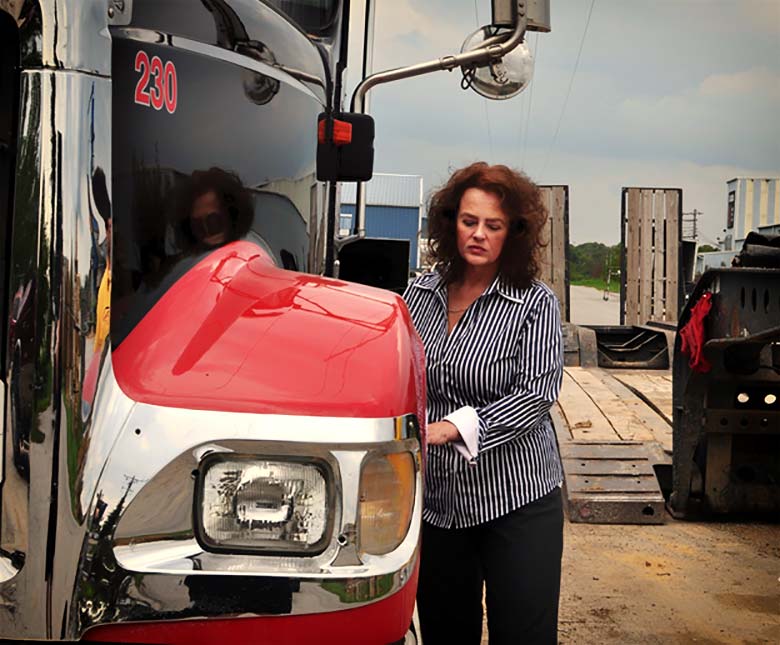When a trucker or commercial vehicle operator’s negligence causes collisions on the road, they often lead to devastating and catastrophic injuries, such as brain injury or even death.
In 2018, there were over 10,000 trucks involved in collisions in Kentucky.
Our experienced Kentucky semi-truck accident lawyers at the Law Firm of Flora Templeton Stuart are committed to holding negligent truckers and their employers responsible for their actions and making highways safer.
If you or a loved one has suffered a serious injury in a Kentucky truck or commercial vehicle accident, call our firm to schedule a free case evaluation. We will secure the compensation you need to recover and get back to normal daily life.
Why Choose Our Kentucky Semi-Truck and Commercial Vehicle Accident Lawyers?
- We represent clients with care, passion, and commitment to their particular needs.
- Our team has secured satisfactory results in court on behalf of the injured for more than four decades.
- Our legal team has recovered tens of millions of dollars for clients.
- Our firm’s founder Flora Templeton Stuart paved the path for female attorneys in Bowling Green as the first to try a personal injury case.
The Importance of Hiring a Kentucky Semi-truck Attorney Right Away
Going up against a trucking company in Kentucky is no small feat. Trucking companies have extensive resources to put toward fighting liability and disputing injury claims, including top attorneys. One of the best ways to protect your rights during a truck accident claim is to hire a lawyer of your own right away.
Delaying could leave enough time for the trucking company or its insurer to take advantage of you. You may unknowingly give the insurance company information that could hurt your claim later, for example, or accept a too-small settlement. A lawyer can complete many case-related tasks on your behalf.
- Truck accident investigation: Our firm has connections to investigators who can revisit the scene of your accident, look into the trucking company and take other steps to get to the bottom of who or what caused your crash. A thorough crash investigation could shed light on liability, damages and your options as a survivor.
- Evidence gathering: We can make calls to preserve important evidence right away, such as the crashed truck’s black box information or a truck driver’s cellphone records at the time of the collision. Waiting too long to hire an attorney could mean the loss of key evidence. We can collect evidence and build a claim to damages on your behalf.
- Determining fault: Fault can be confusing in a truck accident case. For example, the at-fault driver may not be liable for your damages, but the trucking company may be vicariously liable instead. Many lawsuits involve shared fault divided among multiple parties. If you are not sure who to name as the defendant(s) in your personal injury case, we can help.

Your lawyer will help you avoid common mistakes such as trusting an insurance claims adjuster, giving a recorded statement or accepting the first offer. Hire an attorney from our firm before you accidentally make a mistake that could hurt your odds of obtaining compensation.
Injuries Caused by Semi-Trucks and Commercial Vehicles
- Traumatic Brian Injury
- Death
- Internal injuries
- Facial injuries
- Permanent scarring
- Amputation
- Broken bones
- Spinal cord injury
Trucking Company Negligence
Many Kentucky truck accident cases involve the negligence of the trucking company itself rather than a truck driver. The average trucking company oversees dozens of trucks and drivers, as well as operations such as cargo loading and ground traffic control.
Trucking companies have many business responsibilities, including hiring reasonably safe drivers and properly training them. Negligence during hiring or training that ultimately leads to a truck accident could point to truck company liability.
The Federal Motor Carrier Safety Administration (FMCSA) Laws were made for Commercial Motor vehicles for the purposes of keeping our roads and highways as safe as possible. These laws govern many categories of the trucking industry that apply to:
- Hours of service operations
- Drug and alcohol testing
- Securing Cargo
- Vehicle inspections
- Requirements for Licensing
One common mistake truck companies make is improper fleet maintenance. Big rigs require daily inspections and regular truck maintenance to operate safely and efficiently. Drivers must also conduct daily vehicle checks.
Otherwise, trucks could experience serious equipment breakdowns that cause traffic accidents. Brakes going out or tire blowouts, for example, could make a truck driver lose control of the vehicle and crash. It is the truck company’s legal responsibility to properly maintain and repair its trucks.
Improper load securement and lost cargo loads could also point to trucking company responsibility for an accident. The Federal Motor Carrier Safety Administration enforces strict cargo securement laws all truck companies must obey.
Finally, issues such as a trucking company pressuring its drivers to exceed maximum hours of service regulations could lead to liability for accidents. Truck companies can be negligent in many different ways that ultimately lead to accidents, often in the name of profitability. It is our mission to hold negligent trucking companies accountable for their actions.
Wrongful Death Claims in Truck Accidents
Kentucky truck accidents are often fatal for occupants in passenger vehicles. In 2018, 4,136 fatal collisions occurred in the U.S. involved large trucks. Thousands of victims lose their lives in collisions with commercial trucks each year.
If you lost someone close to you in a recent truck accident in Kentucky, hire a wrongful death attorney from the Law Firm of Flora Templeton Stuart for assistance with your claim. A civil lawsuit could bring justice to your deceased loved one, as well as lead to compensation for your damages.
In Kentucky, you have one year from the date of your loved one’s death to file a wrongful death claim. You may have grounds for a wrongful death claim if someone else – such as a truck driver or trucking company – negligently or recklessly caused your loved one’s fatal injury.
Many fatal truck accidents give surviving loved one’s grounds to bring wrongful death lawsuits against the trucking company and/or other parties. You must be a relative or a representative of the deceased person’s estate for the right to file.
A successful wrongful death claim could benefit your family in many ways. First, it could bring you much-needed closure, justice, and peace of mind. It could prove the trucking company or another party was negligent, and that this is what caused your loved one’s fatal accident.
Second, a successful suit could force the trucking company to improve its safety protocols, potentially preventing future truck accidents.
Third, it could end in compensation for your damages. Your family could receive an award for pain and suffering, mental anguish, loss of consortium, funeral costs and more. Speak to a truck accident lawyer to find out if you have the power to bring a wrongful death lawsuit today.
TOP CAUSES OF TRUCK ACCIDENTS IN KENTUCKY
The top ten driver contributing factors in the 9,898 truck accidents for in Kentucky 2018 were reported by the Kentucky Transportation Center and are as follows:
| Driver Contributing Factor | Number of Accidents | Fatal Crashes |
| 1. Driver Inattention | 3,460 | 35 |
| 2. Misjudging Clearance | 1,732 | 2 |
| 3. Not Under Proper Control | 1,422 | 27 |
| 4. Failed to Yield Right of Way | 849 | 8 |
| 5. Following Too Close | 450 | 2 |
| 6. Too Fast for Conditions | 331 | 7 |
| 7. Distraction | 276 | 5 |
| 8. Disregard Traffic Control | 208 | 3 |
| 9. Improper Backing | 178 | 0 |
| 10. Overcorrecting/Oversteering | 172 | 4 |
Other notable factors that are not listed, but are contributors to fatal accidents include alcohol or drug involvement and exceeding the speed limit.
The leading contributing vehicular factors of truck accidents in Kentucky, not involving driver error are:
| Contributing Vehicular Factors | Number of Accidents |
| 1. Load Securement | 127 |
| 2. Tire Failure | 109 |
| 3. Defective Brakes | 80 |
| 4. Tow Hitch Failure | 48 |
| 5. Oversized Load | 47 |
| 6. Lighting Defects | 30 |
| 7. Steering Failure | 20 |
| 8. Overload / Improper Load | 7 |
| 9. Defective Headlights | 6 |
| 10. Other | 284 |
Evidence Gathered in Kentucky Semi-Truck Accident Cases:
- Contact witnesses for statements
- Photographs of the scene
- Photographs and inspections of the vehicles
- Expert Reconstructionist
- Employee/Employer Records
- Drug and alcohol test results
- Cameras, photos and videos
- Electronically Stored Data
- Truck driver logs
- Your medical records
- Driver/Company training materials
Commercial Vehicle Collisions
A commercial vehicle, or company vehicle, can be any kind of vehicle that is owned and operated by a company to be used by employees or agents of that company.
Many times, these vehicles are trucks, box trucks, vans, fire trucks, dump trucks, garbage trucks, forklifts, and even farm trucks hauling all varieties of equipment. Commercial Vehicles are more dangerous than regular vehicles, as they are typically larger and heavier in size, causing more injury.
Commercial vehicles generally are not owned by the person driving them, but the company they work for. These Commercial vehicles have insurance policies that are much larger and provide better coverage than the state minimum policies that common motorist have.
In Kentucky, some commercial vehicles are governed by the same rules and regulations that large semi-trucks are governed by. Under the Federal Rules, vehicles traveling outside of one state to another (Interstate) with a total weight over 10,001 pounds, will have to abide by the Federal Statutes.
Vehicles traveling only within the state of Kentucky (intrastate) have to comply with the stricter regulations if their total weight is 26,000 pounds or more.
Frequently Asked Questions About Semi-Truck Accidents
How are commercial truck accidents different from other auto accidents?
One obvious difference in trucking accidents versus other auto wrecks are the types of injuries involved. Due to their large size and weight, accidents with commercial trucks typically cause more severe injuries than other types of auto accidents which might include brain or spine injuries, broken bones, amputations, burns, other catastrophic injuries, or even death.
In addition to the severity of injuries, a tractor-trailer accident can be much more complex than a wreck involving another car. Commercial trucking companies and drivers are governed by federal laws that could affect liability in these cases. Sometimes determining who is at fault in a semi-truck collision is not as straight-forward as it is in a typical car accident.
Also, in most cases, owners and operators of commercial trucks are required to have a minimum amount of liability insurance—usually a commercial policy—that provides better coverage for injured parties as opposed to ordinary automobile accidents.
If you have been injured in a trucking collision, don’t try to navigate these complex issues on your own. Let Kentucky semi wreck lawyer Flora Templeton Stuart help you get the compensation you deserve in your truck injury case.
What is a commercial truck?
Commercial trucks are in the business of transporting merchandise. These trucks include tractor-trailers, dump trucks, delivery vehicles, semi-trucks, big-rigs, 18-wheelers, and most large freight trucks.
What should I do if I have been injured by a commercial truck through no fault of my own?
If you have been injured in a Kentucky semi accident, seek medical attention immediately. The police should come to the scene of the accident and file a report. If possible, get names and contact information of witnesses and take photos of the vehicles and scene (such as damage to vehicles, skid marks, road signs, or anything that might have contributed to the wreck).
This is especially important in commercial truck accidents as trucking companies sometimes work quickly to destroy vital evidence. Get the name, contact information, license number, trucking company name and insurance details from the truck driver.
Write down details of the wreck including date, time, location, what happened to cause the accident and other details while they are fresh on your mind. Notify your insurance company of vehicle damage and injuries you sustained.
Do not discuss the accident with the at-fault party’s insurance company before consulting with a semi wreck attorney.
I am injured and can’t travel, will you meet me at my home or another location?
If you have been injured in a trucking accident and can’t come to us, we will meet you at your home, in the hospital, or another location that is convenient for you.
We have offices in Bowling Green, Glasgow, Greenville and Scottsville, Kentucky, and we travel throughout Kentucky & Tennessee to meet with our injured clients. If you have been injured in a big-rig collision or commercial vehicle collision, call semi-truck wreck lawyer Flora Templeton Stuart at (888) 782-9090 twenty-four hours a day/seven days a week.
What are common causes of commercial truck accidents?
Common causes for commercial truck and tractor-trailer wrecks include inadequate driver training, driver fatigue, speeding, mechanical failure or safety issues, distracted driving, inherent limitations and capabilities of the vehicle (such as limited visibility, acceleration, and braking distances), improper loading or overloading, or driver impairment due to drugs and alcohol.
Who is at fault in a trucking accident injury case?
Determining who is at fault in a tractor-trailer or commercial vehicle collision can be a complicated process. We will investigate to determine all of the responsible parties in your semi wreck case which could include: truck manufacturer, leasor (the company who leased the truck), owner of the truck and/or trailer, truck driver, trucking company, owner of the cargo, maintenance company, or truck loader.
The trucking company could also be held responsible as an employer or in negligently supervising, training, and/or hiring the truck driver. If you have been injured in a semi accident, contact us for a free case evaluation.
How do trucking laws affect my big-rig wreck case?
In addition to complying with state traffic laws like all other drivers, commercial trucks and drivers are heavily regulated by the Federal Motor Carrier Safety Administration (FMCSA). The FMCSA regulations are designed to promote highway safety and reduce truck wrecks by addressing driver licensing, insurance coverage, drug and alcohol use, vehicle maintenance, maximum load restrictions, and driver rest requirements among other topics.
Unfortunately, these regulations are sometimes overlooked or completely disregarded by trucking companies or drivers—putting other drivers at risk. If you have been injured by a semi-truck or other commercial vehicle, protect your rights by hiring an experienced truck accident lawyer.
Our semi accident attorneys will thoroughly investigate your case to make sure all FMCSA regulations were followed by the trucking company and driver.
What if the truck driver fell asleep at the wheel?
Commercial truck drivers, under the Federal Motor Carrier Safety Regulation, must limit driving hours. If you suspect the truck diver fell asleep at the wheel, it is important to hire a semi-truck wreck attorney to investigate to determine if the regulations were followed—and to determine who is at fault if they were not.
What compensation is available in a semi wreck injury case?
In trucking injury cases, multiple parties could be held liable for your injuries. An experienced truck wreck attorney can help you find all the negligent parties and seek full compensation for your injuries.
In any commercial truck collision injury case, your recovery should take into account the immediate needs of you and your family as well as all future expenses including medical bills, rehabilitation or therapy, lost earning capacity, and long-term care, if needed.
Victims may also be entitled to seek punitive damages, pain and suffering, and other compensation against the at-fault parties. In some cases, the victim’s family can seek restitution for loss of consortium (companionship) or a wrongful death claim if the injuries lead to the passing of their loved one. Contact us 24/7 if you are the victim of a semi-injury.
Who will pay my medical bills and lost wages after a commercial truck accident?
In Kentucky, there should be coverage on the vehicle you were in during the accident called Personal Injury Protection (PIP). This insurance pays for the first $10,000 of your medical bills and lost wages.
At our law firm, we reserve PIP to be used by our clients’ treating physicians. We recommend increasing PIP from $10,000 to $50,000 for better coverage in case of a catastrophic accident.
If your accident-related expenses exceed that amount – as they frequently do in semi-truck wreck cases – you need an experienced Kentucky personal injury attorney to find all the policies that may apply to your claim so you can focus on your recovery.
How long do I have to file suit after a commercial truck or big-rig accident?
In Kentucky, you generally have two years to file suit after a commercial truck accident or two years from the last date of payment from PIP (no-fault) benefits. If the accident involved a fatality, the statute is generally only 1 year to file suit on behalf of the victim’s estate and family.
If you or a loved one has been hurt in a big-rig collision, we urge you to contact our semi accident lawyers immediately so we can take photos of the truck and scene. If you wait, the evidence could be destroyed. Don’t miss your chance to get the compensation you deserve for your semi-truck injury case. Call us at (888) 782-9090 to speak to a truck accident attorney today!
Why should I hire a Kentucky lawyer for my semi collision injury claim?
If you have been injured by an 18-wheeler or other commercial truck, having an experienced Kentucky trucking accident attorney on your side is crucial to getting the compensation you deserve.
Trucking companies want to pay out as little as possible to accident victims so they hire attorneys and experts to fight injury claims. Don’t let a trucking company deny you the benefits you deserve – let an experienced semi-truck accident lawyer help you get the compensation you are entitled to for your injuries.
Common things a semi wreck injury lawyer looks for include:
- Was the driver properly trained and licensed?
- Was the driver suffering from fatigue or rushing to make a deadline?
- Has the driver been involved in other accidents?
- Was the driver distracted by cell phone or texting?
- When did the driver last have a rest period?
- Was the driver using drugs or alcohol?
- When was the last safety inspection performed?
- Has the trucking company been cited for violations in the past?
- Were the truck and trailer functioning properly?
- Was the trailer loaded properly?
Who is at fault in a trucking accident injury case?
We will investigate to determine all of the responsible parties in your semi wreck case which could include: truck manufacturer, leasor (the company who leased the truck), owner of the truck and/or trailer, truck driver, trucking company, owner of the cargo, maintenance company, or truck loader.
The trucking company could also be held responsible as an employer or in negligently supervising, training, and/or hiring the truck driver.
What compensation is available in a semi wreck injury case?
In trucking injury cases, multiple parties could be held liable for your injuries.
An experienced Kentucky truck wreck attorney can help you find all the negligent parties and seek full compensation for your injuries.
Damages Available
Full compensation could mean an award for each of your economic and non-economic damages relating to the commercial truck accident.
Your Kentucky Semi-truck wreck attorney can help you understand what types of damages you may be eligible to receive based on the specifics of your accident case.
Although each claim is unique, state laws in Kentucky allow all truck accident victims to seek the same main categories of compensation.
- Medical expenses: You could be eligible to receive an award for all past and future medical expenses related to your truck accident. This could include the costs of any surgeries, rehabilitation, hospital stays, treatments, medical devices, and medications.
- Property damages: The trucking accident might have totaled your vehicle, for which you could receive a compensation award in the amount of the pre-accident value of the car. You could also recover costs for vehicle repairs in minor accidents.
- Lost wages: If you had to miss work without pay because of your trucking accident, the defendant could owe you a compensation award for your lost income and missed earning opportunities. You could also recover an amount for lost future earning capacity if you suffered a permanent disability.
- Pain and suffering: A noneconomic damage award could make up for intangible losses such as physical pain, mental distress, emotional anguish, post-traumatic stress, lost quality of life or the lost enjoyment of a loved one’s company.
- Punitive damages: Some truck accident cases involving a defendant’s gross negligence or malicious intent to harm could receive punitive damages on top of compensatory ones. Punitive damages punish a defendant for especially wrongful acts.
- PIP benefits: Kentucky law requires vehicles to be insured with PIP coverage. As a driver or passenger of a vehicle, these benefits are there for you, regardless of fault, for medical bills, lost wages and household services. In some instances, these benefits can be paid out to you directly.
Kentucky does not impose a cap on any type of damages in personal injury or wrongful death claims. You could receive as much as your lawyer can claim on your behalf. However, a cap of $750,000 on non-economic damages exists in most personal injury lawsuits.
A lawyer from the Law Firm of Flora Templeton Stuart can help you maximize your payout during a trucking accident claim using proven negotiation strategies.
The insurance company has made an offer for my trucking wreck injury. Should I accept it?
After a Kentucky commercial truck accident, the insurance company may be quick to offer you a settlement. Even though it may sound enticing, never accept any payment from the insurance company before consulting with a truck wreck lawyer – especially if you or your loved one has suffered a catastrophic injury.
If you accept compensation now, you may be giving up your right to file additional claims in the future. Only an experienced attorney can help you determine the full value of your case in terms of past, present, and future medical bills, past and future lost income, and additional losses for you and your family.
Call trucking accident lawyer Flora Templeton Stuart immediately to investigate your claim to ensure you get all the compensation you are entitled to.
How do I pay for an Kentucky attorney in a semi accident injury case?
The Law Firm of Flora Templeton Stuart works on a contingency fee basis. That means we only get paid if you get paid in your truck wreck injury case. Call Kentucky semi-truck accident attorney Flora Templeton Stuart at (888) 782-9090 for a free initial consultation twenty-four hours a day/seven days a week.
If you or a loved one has been injured, don’t wait. Contact an experienced Kentucky semi-truck and commercial vehicle accident lawyer immediately.
When we receive a call from a client who has been injured, our attorneys go to work immediately to protect their rights to full and fair compensation. Our law firm goes the extra mile, using our 40-plus years of experience to right the wrongs and make our clients whole again.
If you’ve been injured, contact us now. Call Flora Templeton Stuart at (888) 782-9090 or contact us online today.







